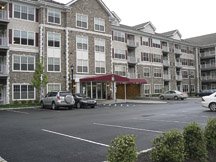Like many low-wage workers, Janice Johnson, a Bayonne resident who works at the Secaucus Walmart, would like to find affordable housing. Johnson, 23, lives with her mother, an older brother, and a niece. She said she’d like to move out and get a place of her own, or maybe share an apartment with a roommate, but “Everything out here is just too expensive.”
She declined to say how much she earns at Walmart, but said she can’t afford the $1,000 to $1,200 rent she sees advertised for one bedroom units at most apartment buildings.
“I guess I have seen some stuff that’s a little cheaper,” she admitted. “But you know what those places are like.”
State policies have created more than 40,000 affordable housing units since 1986, which many believe is a paltry sum.
________
Senate passes controversial bill
Johnson discussed her housing woes days after the state Senate passed S-1, a controversial bill that could dramatically overhaul affordable housing policy in New Jersey.
Current state guidelines dictate that municipalities ensure that:
-developers construct one unit of affordable housing for every four units of market-rate housing; and
-one affordable housing unit is built for every 16 jobs created in town.
The state defines “affordable housing” as units that are sold or rented at below-market rates to people whose incomes meet regional guidelines established by the state Council on Affordable Housing (COAH).
Housing advocates and supporters of the legislation agree that state policies have created just over 40,000 affordable housing units since 1986, a paltry sum they say proves efforts to build affordable housing in New Jersey have failed. The two sides, however, disagree on how best to improve on the past.
Under the new bill, introduced in January by state Sen. Ray Lesniak (D-Union) and state Sen. Christopher Bateman (R-Somerville), COAH – which currently sets affordable housing guidelines – would be abolished.
Instead, oversight of affordable housing policy would shift to the State Planning Commission, and current affordable housing quotas would be eliminated.
Under the proposed new rules, developers could get out of building affordable units by making contributions of $10,000 to municipalities. The municipalities could then use the money to build their own housing, or they could pay other towns to take on their affordable housing requirements.
Supporters of reform believe it will foster affordable housing growth in areas that need it most without financially burdening municipalities and developers.
A companion bill was also introduced in the Assembly, but is currently facing revisions.
Changing the ‘COAH nightmare’
Currently, COAH sets minimum affordable housing quotas for municipalities and periodically updates its formula as to how those quotas should be met. COAH most recently updated its formula in June 2008.
Under current state policy, 115,000 affordable housing units must be built in New Jersey by 2018.
Many officials and people in the business community have found the present requirements onerous, particularly in light of the weak housing market during the recession.
The pending legislation is consistent with proposals Gov. Christopher Christie made last year on the campaign trail.
After taking office in January, Christie convened a housing task force that concluded COAH overstated job and population growth, and thus overstated the need for affordable housing in New Jersey.
After the passage of S-1, Christie said in a released statement: “The legislation passed by the Senate today eliminates COAH and goes a long way toward fundamentally reforming the affordable housing system which New Jerseyans have long demanded and that I have promised to deliver. We will continue to work with members of both parties in the legislature to bring the COAH nightmare to an end and replace a broken system with a common sense, predictable, and achievable process.”
Starting over
Housing rights advocates who say they represent the interests of people like Janice Johnson believe the Senate bill will ultimately reduce the amount of affordable housing in the Garden State.
At a recent press conference, 16 civil rights and housing groups said that if S-1 had been in place since 1986, it would have generated only $767 million for affordable housing. In the same time, COAH has generated $6 billion.
“My sense of this legislation is that will it decrease the funds available for affordable housing overall,” said Santos Murillo, executive director for Habitat for Humanity of Hudson County, an organization that gets most of its funding from the private sector and individual donors.
After years of setbacks, Habitat recently put the final touches on two affordable homes it renovated at 476-478 Ocean Ave. in Jersey City. The families selected to move into these units were required to provide hundreds of hours of help with the renovations. They will get low-interest mortgages on the homes and be owners of the properties, not renters.
While Murillo considers the Ocean Avenue project to be a success story, he noted that there are currently 15,000 people on the waiting list for Section 8 in Jersey City alone, an indication of the need for more affordable housing options in the county.
Housing advocates have successfully convinced leadership in the Assembly to take a closer look at its version of the affordable housing legislation, known as A-2057.
“Our expectation is that they’re going to start over and we look forward to participating in a process that is not as flawed as the one that Sen. Lesniak led,” said Kevin Walsh, staff attorney for the Fair Share Housing Center.
Walsh and other advocates complained that Lesniak, chairman of the senate Economic Growth Committee, refused to let them testify on S-1 and its possible impact on people like Johnson.
Walsh added that whichever reform law gets passed should place affordable housing close to jobs and transportation hubs, like the Frank R. Lautenberg Rail Station in Secaucus (see sidebar).
E-mail E. Assata Wright at awright@hudsonreporter.com.
